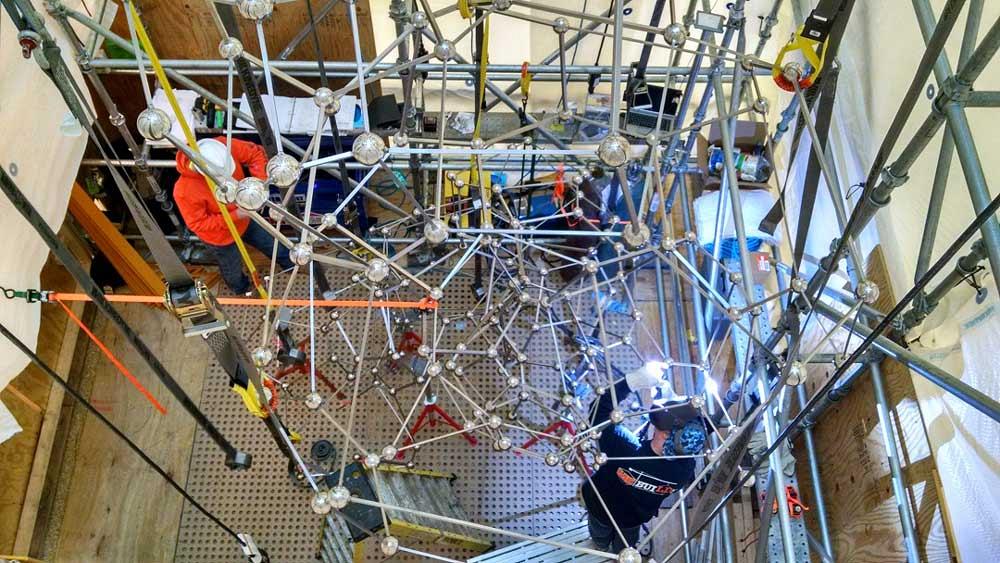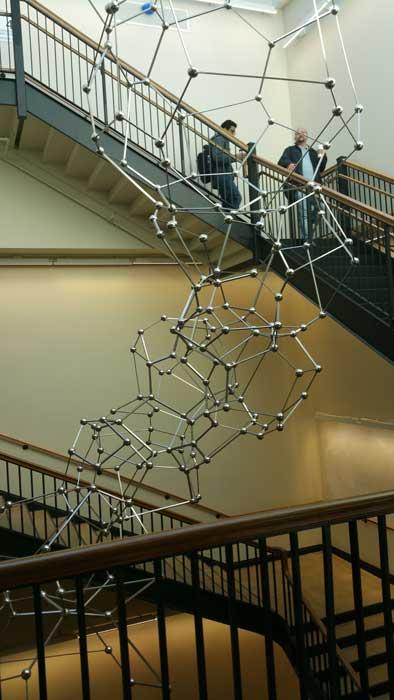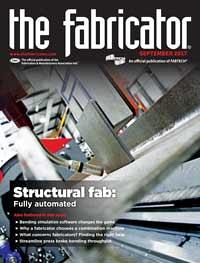- FMA
- The Fabricator
- FABTECH
- Canadian Metalworking
Categories
- Additive Manufacturing
- Aluminum Welding
- Arc Welding
- Assembly and Joining
- Automation and Robotics
- Bending and Forming
- Consumables
- Cutting and Weld Prep
- Electric Vehicles
- En Español
- Finishing
- Hydroforming
- Laser Cutting
- Laser Welding
- Machining
- Manufacturing Software
- Materials Handling
- Metals/Materials
- Oxyfuel Cutting
- Plasma Cutting
- Power Tools
- Punching and Other Holemaking
- Roll Forming
- Safety
- Sawing
- Shearing
- Shop Management
- Testing and Measuring
- Tube and Pipe Fabrication
- Tube and Pipe Production
- Waterjet Cutting
Industry Directory
Webcasts
Podcasts
FAB 40
Advertise
Subscribe
Account Login
Search
Fabricating fixtures before fabricating steel
Vast structure’s success rests on complex fixturing
- By Eric Lundin
- September 20, 2017
- Article
- Arc Welding
If it’s true that life imitates art, it wouldn’t be surprising to find sculptures on university campuses inspired by mathematics, chemistry, or biology. Although such structures tend to be complex in their designs and therefore challenging to build, they usually are worth the effort, admirable and more than a little awe-inspiring when finished.
When the staff of Summit Metal Fabricators, Plaistow, N.H., received a call from the office of internationally acclaimed sculptor Antony Gormley, they were ready. Gormley’s office needed a contractor with a wealth of experience in structural projects and ornamental metals, and Summit turned out to be an ideal fabricator for this sculpture.
A Vast Molecular Structure
The project, developed for a private university on the East Coast, is a vast sculpture that resembles the molecular structure of a chemical chain.
Consisting of 541 nodes, or spheres, and 905 connecting rods, “CHORD” occupies a stairwell, filling an area that measures 12 by 12 by 56 feet high.
“Antony wanted an industrial-looking finish on the bars, and a mirror polish, specifically a #8 finish, on the nodes,” said Chief Estimator Kris Kraft. This led the Summit team to choose SAE 316 stainless steel for the nodes and 2205 duplex stainless steel in a variety of lengths and diameters for the connecting rods.
Modeling the structure was the first big step. “We used building information modeling, or BIM, which is software for 3-D modeling for construction projects,” said Kraft. “We used it to locate each of the spheres in 3-D space, then connected the rods to the nodes.”
So far, so good, but this was just a model. Time-consuming, but not necessarily difficult. Turning this 3-D rendering into a physical entity was the challenge. How would they build the fixturing and rig everything?
“We’re well-versed in building custom jigs, but this was an extreme version of it,” Kraft said. “We built a jig on the floor of our shop, an X-Y axis grid platform, and used CNC equipment to drill 7,000 holes on 50-mm centers,” he said. To get each sphere to the right location, Summit staff located its spot on the X and Y axes of the platform, drilled a hole in that location, then inserted a pipe that had been cut to the correct length to get to the right elevation on the Z axis (see Figure 1). After placing several spheres onto several pipes, they were ready to start welding to connect spheres to rods.
Welding, Heating, Shrinking, Reworking
The rods were tricky.
“The alloy for the rods, 2205 duplex stainless, is available only in plate,” Kraft said. “We used cold-drawn stainless plate that was cut into segments and drawn through a set of dies to turn them into bar form,” he said. Each rod end was ground to a point so that Summit welders could achieve full-penetration welds.

Figure 1
Locating every sphere in 3-D space started with a template on the floor that mapped out the locations along the first two dimensions, the X and Y axes.
Welding dissimilar metals is always a challenge, as is welding a duplex material, but on this project, a far more critical problem was the anticipated dimensional changes caused by the welding heat and subsequent cooling.
“The bars would shrink when we welded them,” Kraft said. “We would have to predict how much they would shrink so we could keep the bars at the proper angle and located at the center point of each node.
This was the biggest challenge our shop faced.”
The longer the spans, the more problematic the distortion becomes, and the severity can be unpredictable. This is where experience and intuition came into play. Summit’s staff has no shortage of either one, so some heating and reworking throughout the project kept it properly aligned so it eventually met the artist’s vision (and fit into the stairwell).
To deal with the logistics, Summit built the structure in six separate sections in its shop (see Figure 2). After moving each section to the work site, it planned 43 field welds to assemble it.
Take It From the Top
The installation sequence might seem hard to believe—well, it is hard to believe—because it started from the top.
“The structure ties into a skylight, and we couldn’t start from the bottom, because gravity would compress it, and it would never reach the top,” Kraft said. Instead, Summit rigged the first section with a lifting frame and chain hoist to get it to the ceiling. After it was in place, Summit assembled it downward. Gravity was still a factor, causing the structure to stretch, so the Summit crew strapped each section along the way to support the structure.
“When the welders were finished, the bottom of the structure was about 12 in. off the floor,” Kraft said. This wasn’t a surprise—Summit had anticipated this. At this point, gravity became Summit’s ally. The rigging team carefully removed the straps, and gravity did the rest. The center dropped to the floor for a perfect placement.
The sculpture won four awards: Engineering News-Record (ENR) Best Projects Regional Award, ENR Best of the Best Projects National Award, Associated Builders and Contractors Excellence in Construction Award, and the American Institute of Steel Construction’s Ideas2 National Award.
Summit Metal Fabricators, 603-328-2211, www.summitmetalfab.com
About the Author

Eric Lundin
2135 Point Blvd
Elgin, IL 60123
815-227-8262
Eric Lundin worked on The Tube & Pipe Journal from 2000 to 2022.
subscribe now

The Fabricator is North America's leading magazine for the metal forming and fabricating industry. The magazine delivers the news, technical articles, and case histories that enable fabricators to do their jobs more efficiently. The Fabricator has served the industry since 1970.
start your free subscription- Stay connected from anywhere

Easily access valuable industry resources now with full access to the digital edition of The Fabricator.

Easily access valuable industry resources now with full access to the digital edition of The Welder.

Easily access valuable industry resources now with full access to the digital edition of The Tube and Pipe Journal.
- Podcasting
- Podcast:
- The Fabricator Podcast
- Published:
- 04/16/2024
- Running Time:
- 63:29
In this episode of The Fabricator Podcast, Caleb Chamberlain, co-founder and CEO of OSH Cut, discusses his company’s...
- Trending Articles
Tips for creating sheet metal tubes with perforations

Supporting the metal fabricating industry through FMA

JM Steel triples capacity for solar energy projects at Pennsylvania facility

Are two heads better than one in fiber laser cutting?

Fabricating favorite childhood memories

- Industry Events
16th Annual Safety Conference
- April 30 - May 1, 2024
- Elgin,
Pipe and Tube Conference
- May 21 - 22, 2024
- Omaha, NE
World-Class Roll Forming Workshop
- June 5 - 6, 2024
- Louisville, KY
Advanced Laser Application Workshop
- June 25 - 27, 2024
- Novi, MI




























